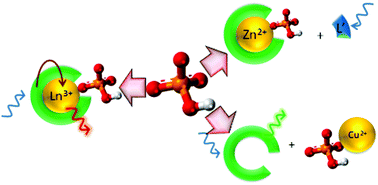当前位置:
X-MOL 学术
›
Chem. Soc. Rev.
›
论文详情
Our official English website, www.x-mol.net, welcomes your
feedback! (Note: you will need to create a separate account there.)
Design and applications of metal-based molecular receptors and probes for inorganic phosphate.
Chemical Society Reviews ( IF 40.4 ) Pub Date : 2020-02-04 , DOI: 10.1039/c9cs00543a Mandapati V Ramakrishnam Raju 1 , Sarah M Harris 2 , Valérie C Pierre 1
Chemical Society Reviews ( IF 40.4 ) Pub Date : 2020-02-04 , DOI: 10.1039/c9cs00543a Mandapati V Ramakrishnam Raju 1 , Sarah M Harris 2 , Valérie C Pierre 1
Affiliation

|
Inorganic phosphate has numerous biomedical functions. Regulated primarily by the kidneys, phosphate reaches abnormally high blood levels in patients with advanced renal diseases. Since phosphate cannot be efficiently removed by dialysis, the resulting hyperphosphatemia leads to increased mortality. Phosphate is also an important component of the environmental chemistry of surface water. Although required to secure our food supply, inorganic phosphate is also linked to eutrophication and the spread of algal blooms with an increasing economic and environmental burden. Key to resolving both of these issues is the development of accurate probes and molecular receptors for inorganic phosphate. Yet, quantifying phosphate in complex aqueous media remains challenging, as is the development of supramolecular receptors that have adequate sensitivity and selectivity for use in either blood or surface waters. Metal-based receptors are particularly well-suited for these applications as they can overcome the high hydration enthalpy of phosphate that limits the effectiveness of many organic receptors in water. Three different strategies are most commonly employed with inorganic receptors for anions: metal extrusion assays, responsive molecular receptors, and indicator displacement assays. In this review, the requirements for molecular receptors and probes for environmental applications are outlined. The different strategies deployed to recognize and sense phosphate with metal ions will be detailed, and their advantages and shortfalls will be delineated with key examples from the literature.
中文翻译:

无机磷酸盐的金属基分子受体和探针的设计和应用。
无机磷酸盐具有许多生物医学功能。磷酸盐主要由肾脏调节,在患有晚期肾脏疾病的患者中血磷达到异常高的水平。由于不能通过透析有效地去除磷酸盐,因此产生的高磷酸盐血症导致死亡率增加。磷酸盐也是地表水环境化学的重要组成部分。尽管需要无机磷来确保我们的食品供应,但无机磷还与富营养化和藻华的扩散联系在一起,从而增加了经济和环境负担。解决这两个问题的关键是开发无机磷酸盐的精确探针和分子受体。但是,定量分析复杂水性介质中的磷酸盐仍然具有挑战性,超分子受体的发展也是如此,这种超分子受体具有足够的灵敏度和选择性,可用于血液或地表水。金属基受体特别适合这些应用,因为它们可以克服磷酸盐的高水合焓,从而限制了水中许多有机受体的有效性。无机受体最常采用三种不同的策略来处理阴离子:金属挤压分析,响应性分子受体和指示剂位移分析。在这篇综述中,概述了用于环境应用的分子受体和探针的要求。将详细介绍用于识别和感测金属离子中的磷酸盐的不同策略,并将通过文献中的关键示例来描述其优势和不足。
更新日期:2020-02-24
中文翻译:

无机磷酸盐的金属基分子受体和探针的设计和应用。
无机磷酸盐具有许多生物医学功能。磷酸盐主要由肾脏调节,在患有晚期肾脏疾病的患者中血磷达到异常高的水平。由于不能通过透析有效地去除磷酸盐,因此产生的高磷酸盐血症导致死亡率增加。磷酸盐也是地表水环境化学的重要组成部分。尽管需要无机磷来确保我们的食品供应,但无机磷还与富营养化和藻华的扩散联系在一起,从而增加了经济和环境负担。解决这两个问题的关键是开发无机磷酸盐的精确探针和分子受体。但是,定量分析复杂水性介质中的磷酸盐仍然具有挑战性,超分子受体的发展也是如此,这种超分子受体具有足够的灵敏度和选择性,可用于血液或地表水。金属基受体特别适合这些应用,因为它们可以克服磷酸盐的高水合焓,从而限制了水中许多有机受体的有效性。无机受体最常采用三种不同的策略来处理阴离子:金属挤压分析,响应性分子受体和指示剂位移分析。在这篇综述中,概述了用于环境应用的分子受体和探针的要求。将详细介绍用于识别和感测金属离子中的磷酸盐的不同策略,并将通过文献中的关键示例来描述其优势和不足。











































 京公网安备 11010802027423号
京公网安备 11010802027423号